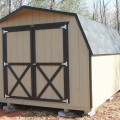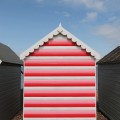If your dog spends a significant amount of time outside, he or she might need a dog house or kennel to provide protection from the elements (snow, rain, etc.), escape from the cold, shade from the sun and, in general, a place to feel safe and secure—like a den.
A quality dog house can last a long time when properly maintained. Here are some tips to keep your best friend’s shelter up to par as well as some ideas for improvements:
- Check the roof for leaks—replace shingles as needed—and make sure nails do not go through roof! Eventually, you may have to repair the roof.
- Replace any worn wood, or repaint any areas that are faded/chipped.
- Check the ground; make sure the dog house is still on a flat surface. Consider adding a foundation (or even place atop a pallet) to give some room between the floor and hot or cold ground.
- If you live in a colder climate, consider adding a vinyl flap to the door to help keep cool air and elements out. Insulation or waterproofing are two other ways to help keep the dog house comfortable and dry.
- Check every week or so to make sure straw and/or bedding is clean and dry; while not technically a repair, the living conditions are important to monitor regularly.
- Monitor your dog’s growth—if you got your dog house when he was just a puppy, chances are he could’ve outgrown his cozy shelter. You might need to upgrade to a bigger dog house or even a kennel.
- Trim weeds around your dog house, and be sure to use pet-friendly pesticides for any landscaping/gardening near your dog house.
In today’s busy era, it’s easy to “set it and forget it”, but when it comes to your dog’s health and safety, you should keep up with his outdoor accommodations and address any repair needs as soon as possible.
Remember! Dog houses provide great shelter, but pups also look to their people for companionship and fun—they’re social by nature.

